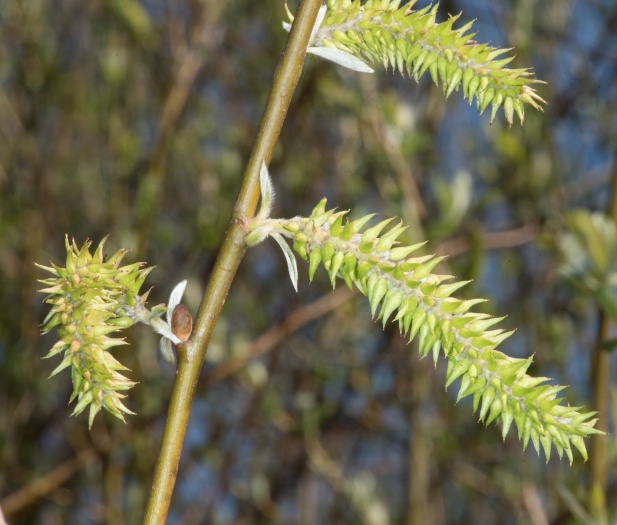Dusky Willow
(Salix melanopsis)
Dusky Willow (Salix melanopsis)
/
/

© Don Loarie
CC BY 4.0
Image By:
© Don Loarie
Recorded By:
Copyright:
CC BY 4.0
Copyright Notice:
Photo by: © Don Loarie | License Type: CC BY 4.0 | License URL: http://creativecommons.org/licenses/by/4.0/ | Uploader: dloarie | Publisher: iNaturalist |

























Estimated Native Range
Summary
Salix melanopsis, commonly known as Dusky Willow, is a deciduous shrub native to riparian zones, wetlands, and subalpine meadows in western North America, from British Columbia and Alberta to California and Colorado. It thrives along riverbanks and streams where the soil is consistently moist. Typically, Dusky Willow can reach up to 13 feet in height and is known for forming colonial thickets through vegetative reproduction. The shrub features pointed, lance-shaped leaves that may exceed 5 inches in length, with margins that are either smooth or spine-toothed. During the flowering season, which occurs in early spring before the leaves emerge, the plant produces catkins that can be up to 6 inches long, adding subtle interest to the landscape.
Dusky Willow is valued for its ability to stabilize soil and prevent erosion in wetland restoration projects. It is also used in wildlife gardens, as it provides habitat and food for various species. In cultivation, it requires consistently moist soil and can tolerate a range of conditions from full sun to partial shade. While it is not typically grown for ornamental purposes, its natural form can add a wild, rustic charm to the right setting. Gardeners should be aware that, like many willows, it can be susceptible to pests such as aphids and diseases like willow scab and black canker. It’s also important to plant it away from septic systems and foundations due to its water-seeking roots.CC BY-SA 4.0
Dusky Willow is valued for its ability to stabilize soil and prevent erosion in wetland restoration projects. It is also used in wildlife gardens, as it provides habitat and food for various species. In cultivation, it requires consistently moist soil and can tolerate a range of conditions from full sun to partial shade. While it is not typically grown for ornamental purposes, its natural form can add a wild, rustic charm to the right setting. Gardeners should be aware that, like many willows, it can be susceptible to pests such as aphids and diseases like willow scab and black canker. It’s also important to plant it away from septic systems and foundations due to its water-seeking roots.CC BY-SA 4.0
Plant Description
- Plant Type: Shrub, Tree
- Height: 6-15 feet
- Width: 4-8 feet
- Growth Rate: Moderate
- Flower Color: N/A
- Flowering Season: Spring, Summer
- Leaf Retention: Deciduous
Growth Requirements
- Sun: Full Sun, Part Shade
- Water: High
- Drainage: Medium, Slow, Standing
Common Uses
Bank Stabilization, Erosion Control, Water Garden
Natural Habitat
Native to riparian zones, wetlands, and subalpine meadows in western North America
Other Names
Common Names: Dark Sandbar Willow, Black Willow
Scientific Names: , Salix melanopsis, Oisodix fulva, Salix bolanderiana, Salix exigua subsp. melanopsis, Salix exigua var. gracilipes, Salix exigua var. melanopsis, Salix exigua var. tenerrima, Salix fluviatilis, Salix fluviatilis var. tenerrima
GBIF Accepted Name: